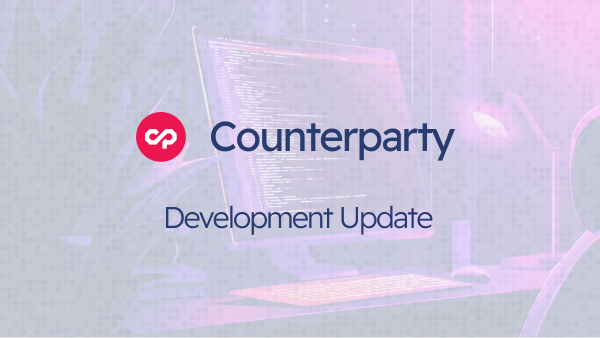From the Team
The much anticipated Counterparty desktop wallet is in its final testing phase, with the beta version scheduled to be released early next week. Below we’re providing detailed description of the wallet, its features and installation procedure.
Introduction
counterparty-gui is the graphical desktop wallet for Counterparty. It can be used as a classical wallet (with a local Counterparty server), as well as a light wallet compatible with Counterwallet.
Installation
Installation of the wallet on Windows and MacOS has been automated with the standalone installers.
In the near future, the wallet will be configured to run in ‘light’ mode by default. This means you will no longer have to run a local instance of bitcoin/counterparty or download the blockchain.
Architecture
Cross-platform – counterparty-gui can be executed on all platforms supported by PyQt5.
Flexible – Like counterparty-client, counterparty-gui requires a counterparty-server and a wallet, and like it, it can be used as a light wallet, a classical wallet or even a mix:
- with a public distant counterparty-server and a private local BIP32 light wallet compatible with Counterwallet (under development).
- with a private local counterparty-server and a private local btcwallet both using a public distant btcd server
- with a public distant counterparty-server and private local Bitcoin Core
Secure – All transactions generated by the counterparty-server are verified client-side to ensure that what we get from a potential untrusted public counterparty-server is exactly what we asked.
Open – counterparty-gui uses counterpartycli.clientapi to communicate with the counterparty-server and the Wallet. counterpartycli.clientapi provides all the necessary methods to easily develop an alternative Counterparty Wallet.
Extensible – In counterparty-gui everything is a plugin. The core application only manages the left menu of the GUI and the configuration dialog box. Each plugin adds one or more items in this menu. When the user clicks on one of these items, the core application displays the corresponding plugin in the main window. Plugins can be written in QML/Javascript, and in the near future also in HTML/CSS/Javascript. In both cases they can use directly an instance of counterpartycli.clientapi from Javascript. counterparty-gui is designed as much for end users as for developers. It is the last brick to make the Counterparty suite, the standard framework to develop Bitcoin 2.0 applications, from the backend to the desktop GUI.
From the Community
Big news from the community this week – Counterparty got a new blockchain explorer thanks to the hard work of a community member. On March 1st, Jeremy “J-Dog” Johnson announced the launch of a new crypto 2.0 services company named CoinDaddy which, amongst other things, offers a free blockchain explorer to Counterparty users – the CounterpartyChain. Besides displaying detailed information from the blockchain, CounterpartyChain also supports enhanced assets and enhanced broadcasts, meaning that all of the additional information (such as contact or website) associated with an asset or a bradcast are now displayed on a dedicated asset/broadcast page.
Another useful service offered by CoinDaddy is the Asset WHOIS which collects and displays all known information about a particular asset. This service can be extremely helpful in identifying fraudulent assets and asset name squatting. By checking the asset on the Whois service users can easily distinguish a fraudulent asset from a legitimate one (given that the asset owner provided such information). Similar service is also available for broadcast information
Besides these free tools and services, CoinDaddy offers some additional paid features, such as Asset Registration, Asset Transfer/Escrow (which allows asset owners to list their assets for sale), and Asset and Broadcast Enhancement (which offers asset owners to associate extended information with their asset or broadcasts).
Another community effort this week is the development of a Counterparty developer specification. @deweller started writing a developer-level specification for the Counterparty protocol. You can check out his decoding documentation, monitor the progress, or help with development on GitHub
Support Updates
Our support team has been hard at work at testing the new product versions across various different operating systems. counterparty-gui and client are designed to work on all OS, and below we provide a list of OS that have so far been tested and confirmed to work. Note, however, that due to various issues with Python 3 and its modules, the installation of Python modules required by Counterparty may be less smooth than on Ubuntu 14.04 and Windows 7. Users are welcome to share their problems and solutions on our new and improved community forum.
- Arch Linux release 2015.03.01
- CentOS 6.6 x86-64
- CentOS 7 x86-64
- Debian 14.04 LTS x86-64 (current)
- Debian jessie/sid (v8, 3.16.0-4-amd64) x86-64
- Debian wheezy (v7.7.0) x86-64
- Fedora Server 21 i686
- FreeBSD 10.1 x86-64
- OpenSuSE 13.2 x86-64
- Raspbian 8 (armhf)
- Ubuntu 14.10 i386
- Windows 7 x64
- Windows Server 2012 x64
That concludes our update for this week. If you have any questions you can contact us via our support channel, gitter, forum or github.
